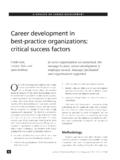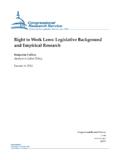Transcription of The impact of technology on organizational performance
1 Repeated economic crises and steadily increasingcompetition, brought about in particular by theglobalization of markets, are forcing an unprece-dented rationalization of resources. Improved productivityhas thus become a concern of all organizations, bothpublic and private. At the same time, technology is devel-oping with blinding speed and is becoming the principalinstrument for meeting this explains whymany municipalities are investing large amounts of moneyin implementing information systems. However, the advan-tages offered by technologies, especially in terms ofenhancing productivity, depend upon how these technolo-gies are integrated into an municipal officials realize that their systemsdepartments do not have the necessary resources to meetthe demands made on them. More and more time isrequired to complete projects and the work piles , these officials often find that technological, orga-nizational and human resource development processes arenot proceeding at the same pace within their organization,which makes them hesitant about adding new penetration of technologies really helping to improvethe performance of municipalities?
2 To answer this question,the extent to which information systems are incorporatedinto the culture and operations of municipal governmentsmust be concrete action system model developed byGagnon and Landry and refined by Dragon outlines a strat-egy for investigating technological changes that affectunionized work the authors note, This roadmap, here called the concrete action system, tries to iden-tify and characterize the principal actors involved in theactivity of implementing systems, and then to establish therelationships among these actors. 4 The concept of a concrete action system is based onthe fact that an organization is a social system whosedynamics are grounded in the behaviour of groups of actorswho develop particular strategies in a set of relationshipsOptimum, The Journal of Public sector Management Vol. 28, No. 1 (19-31)The impact of technology onorganizational performanceYves-C.
3 Gagnon andJocelyne Dragon19 Jocelyne Dragon is the assistant director of administration andfacilities with the recreation and community development depart-ment of the City of Saint-Laurent and is also a member of the man-agement committee for the City s information highway project. Shehas a Master s degree in Public Gagnon is a full professor at the cole nationale d adminis-tration publique. He has a PhD in Management from the cole deshautes tudes commercialesin Montreal, an MBA inOrganizational Information Systems from Laval University and anMSc in Industrial Relations from the University of Gagnon teaches and conducts research in technology manage-ment, human resource management and labour relations. He alsohas some twenty years experience as a manager with organiza-tions in the public and parapublic in productivity is duenot only to technology , but also tohow it s integrated into the are subject to the constraints of the contain individuals and groups who differ intheir training and functions and have objectives that do notalways coincide.
4 Obviously, relationships differ according tocontext and are not spelled out in a formal structure such asan organization such a context, systems development provides theopportunity and the place for potential conflicts betweeninterests, aspirations and values that involve something otherthan just technology . 6 Figure 1 illustrates the concrete actionsystem, showing the principal actors and how they relate toeach other when organizational information systems areadopted ( , the acquisition, successful implementation anduse of a technology by an organization).7 The users/decision makers are senior managers whopartially or completely control resources and influencethe development of information systems. The users/managers are those who, on behalf of theusers/decision makers, supervise the implementationand operation of systems in collaboration with thedesigners. It is at their level that the collective agreementOptimum, The Journal of Public sector Management Vol.
5 28, No. 1 THE impact OF technology ON organizational PERFORMANCE20 FIGURE 1 Concrete action systemUsers/Decision makersUsers/Managers/DesignersUsers/Mana gersDesignersOthersystemsSystemClientsUs ers/OperatorsLocal unionUnionrepresentativeCollectiveagreem entOthercollectiveagreements CentrallabourorganizationOthersitesOther sitesis negotiated and interpreted, particularly with respect tothe clauses concerning technological change. The users/managers/designers run the systems depart-ment and are often the architects of the organization sinformation technology policies, which are ratified bythe users/decision makers. The users/managers/designers are responsible for the design and technicalmanagement of information systems. The designers are the experts who design systems incollaboration with the users/managers and are, if not the only ones responsible for makingsystems operational, at least in charge of the work. The users/operators produce inputs or receive rawoutputs from the systems, which are thought out interms of the clients.
6 They are indispensable for theday-to-day operation of the systems, but do not haveany direct power to change them. The local union is located at the interface between theusers/operators and the users/managers. The aim ofthe local union is to defend the immediate interests ofits members, the users/operators. The central labour organization is responsible for theoverall long-term strategy, which provides a frame-work for and supports the actions of the local union. The clients (users/decision makers, users/managers,etc.) are those whom the systems help directly in theperformance of their processTo study a contemporary pragmatic phenomenon, it isessential to be familiar with the experience of the actors andthe context in which that experience takes place. We haveselected the case of an anonymous City first analyzed many internal documents of thismunicipal government. These documents describe the City,the history of its administrative development and its strate-gic plan, technology strategy, systems department and theinformation systems it has adopted.
7 Then, using a semi-structured scheme, we carried out exhaustive interviewswith a random sample of 20 permanent employees whohad at least five years of experience with the municipalityand had taken part in implementing information category of actor was represented in the sample (twousers/decision makers, three users/managers, threeusers/managers/designers, two designers, two clients, sixusers/operators and two officials of the local union). Therespondents worked at seven different hierarchical levels inseven different municipal departments (administration,finance, human resources, systems, municipal court, engi-neering and fire prevention). Apart from the designers,none of the respondents had taken courses in informationtechnology as part of his or her basic training; however,some had taken professional development courses withinthe organization or, in certain cases, outside City and its technologicaldevelopmentThe city whose government we selected had approxi-mately 70,000 inhabitants and was typical, with residential,industrial and commercial functions.
8 Its administrative struc-ture comprised an executive level and twelve departments,which were grouped into three different modules: quality ofthe environment (industrial and business development,technical planning, engineering and environment); qualityof life (recreation and community development, communi-cations, public works and fire prevention); and administra-tion (finance, systems, human resources and purchasing).For 1995, the City s total budget was $150 million, of percent was used to pay salaries and percent($305,600) to acquire information technologies. The budgetof the systems department was $ systems department was the administrative unitresponsible for systematizing and computerizing activitiesfor all the municipal departments. In concrete terms, thisdepartment developed budgets and investment strategiesconcerning information technologies for all of the City sadministrative units.
9 It also administered the organization sdata and was responsible for the development of informa-tion systems. Finally, it ensured that users had the requiredinformation technology tools, that they knew how to usethem properly and that the systems met their needs. Allactivities of the systems department had to meet the follow-ing objectives: improvement of the quality and efficiency ofOptimum, The Journal of Public sector Management Vol. 28, No. 121 THE impact OF technology ON organizational PERFORMANCEthe services provided internally and externally; increasedproductivity; reduction of operating costs; and enhancementof the quality of City s technological development started with theintroduction of information systems between 1965 and1972, and involved automating a large number of manualactivities that were already well established (payroll, taxcollection, etc.). The information systems were useful forfinance and the central computer was then used as anadvanced form of accounting 1972 to 1984, a number of other departmentswanted to take advantage of computer resources and com-petition ensued as requests for new technology accumu-lated.
10 Since the design of information systems was expen-sive and rationalization was therefore necessary, in 1983management established a master plan for information sys-tems. This plan recognized that managers were whollyresponsible for running information systems. In particular,the plan noted: Managers are the people who, throughtheir day-to-day activities, are capable of managing theseinformation systems; in other words, they see to it thatexisting systems are maintained in an acceptable opera-tional condition and control the development of new infor-mation systems. The plan also emphasized that thisresponsibility must be exercised through close cooperationbetween the user departments and the systems master plan set the objective of diversifying thepotential users of information technology , a new direction,since finance was then the principal user. It also empha-sized the importance of continuing to invest money tomaintain the proper operation of existing information sys-tems and to ensure the development of new , the plan also advocated the creation of an informa-tion systems development plan.




